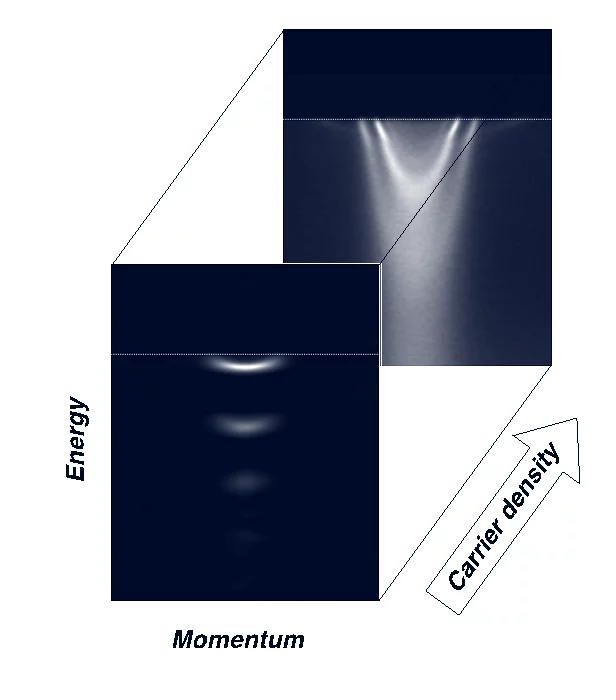The band insulator strontium titanate SrTiO3 (STO), widely used as substrate for growing oxide films, is a highly fascinating material in its own right. Most notably, novel physical properties have been observed at the interface between STO and the materials grown on it. For instance, combined with a thin layer of LaAlO3, stoichiometric STO can host a 2D electron liquid that displays superconductivity. This system is already considered for the realization of next-generation electronic devices. A second example is the appearance of superconductivity above the temperature of liquid nitrogen in a single monolayer of FeSe grown on STO. Its critical temperature is higher than in any iron-based bulk material, suggesting a key-role of the STO substrate.
An international group of scientists has teamed up under the lead of researchers at Paul Scherrer Institute PSI and the University of Geneva to investigate why STO is special. The scientists first prepared the bare surface of STO in a way to host a 2D electron liquid (2DEL) with tunable carrier density. The measurements then performed on this 2DEL revealed that at low carrier density, electrons were always accompanied by a quantized dynamic lattice deformation, i.e. a cloud of phonons. Together with the electron, these phonon-cloud formed a new composite quasiparticle called Fröhlich polaron. These Fröhlich polarons were observed to still move in a band-like fashion through the solid, although with an increased effective mass.
Since the long ranged interaction between electrons and phonons has long been considered favorable for superconductivity by helping electrons pair up, the scientist wanted to reveal which mechanisms assist in a stabilization of Fröhlich polarons. They found that it depended strongly on the amount of doping of the STO surface: Increasing the doping resulted in the electrons and phonons interacting weaker and over shorter distances, causing the Fröhlich polarons to dissociate. Their findings are a first step in the search for a tuning knob with which to tailor interface superconductivity.
For their studies, the scientist employed high-resolution Angle-Resolved Photoemission Spectroscopy (ARPES), a uniquely powerful technique for visualizing the motion of electrons in crystalline solids. They performed ARPES measurements at the Swiss Light Source SLS at PSI, at Diamond Light Source in Didcot, UK, and the BESSY II, Berlin, Germany. Collecting Energy-momentum intensity maps at low carrier densities i.e. amounts of doping, they could visualize replica bands separated by 100 meV from the main bands and confidently ascribe them to stem from Fröhlich polarons. When repeating the experiment at increasing carrier densities, these replica bands became weaker and weaker, indicating a dissociation of the Fröhlich polarons.
These findings, published in Nature Materials, provide a clear microscopic basis for understanding why superconductivity has been observed in different STO based systems at low carrier densities only, disappearing whenever the doping was increased.
Original publication
Tailoring the nature and strength of electron–phonon interactions in the SrTiO3(001) 2D electron liquidZ. Wang, S. McKeown Walker, A. Tamai, Y. Wang, Z. Ristic, F. Y. Bruno, A. de la Torre, S. Riccò, N. C. Plumb, M. Shi, P. Hlawenka, J. Sánchez-Barriga, A. Varykhalov, T. K. Kim, M. Hoesch, P. D. C. King, W. Meevasana, U. Diebold, J. Mesot, B. Moritz, T. P. Devereaux, M. Radovic & F. Baumberger
Nature Materials (2016), published online: 11 April 2016.
DOI: 10.1038/nmat4623
Contact
Milan RadovicLaboratory for Synchrotron Radiation — Condensed Matter Physics
Swiss Light Source, Paul Scherrer Institute
5232 Villigen PSI, Switzerland
Phone: +41 56 310 5565, e-mail: milan.radovic@psi.ch
Felix Baumberger
Department of Quantum Matter Physics, University of Geneva
24, quai Ernest-Ansermet
1211 Geneva 4, Switzerland
Phone: +41 22 379 3441, e-mail: Felix.Baumberger@unige.ch
